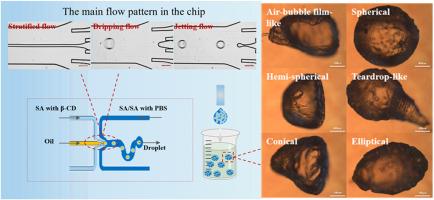基于无量纲分析控制形态的环糊精/海藻酸盐微胶囊的微流控生产
IF 11
1区 农林科学
Q1 CHEMISTRY, APPLIED
引用次数: 0
摘要
我们报道了一种将微流体生成与氯化钙溶液凝胶化相结合的方法,以环糊精(CD)稳定液滴为模板制备微胶囊。以精油为内相,CD为中相,海藻酸钠(SA)为外相,在微通道中形成乳状液滴。我们确定了三种不同的流动形式:分层流动、滴下流动和喷射流动,作为液相流速比的函数,并揭示了液滴凝胶化过程中的过程变量如何控制微胶囊的形态。微胶囊的形成过程包括冲击驱动变形、扩散控制渗透和重力沉降。此外,使用欧内乔治(Oh)和雷诺(Re)数的无量纲分析量化了粘性、惯性和界面力在形成瞬态液滴行为中的竞争作用。值得注意的是,磷酸盐离子通过调节交联动力学诱导各种结构形态,包括泪滴状、半球形、球形、圆锥形和椭圆形。微胶囊具有良好的单分散性、尺寸可控、包封效率高、缓释性能好等特点。这项工作为定制微胶囊结构建立了一个预测框架,强调了流固耦合和工艺设计之间的关键相互作用。本文章由计算机程序翻译,如有差异,请以英文原文为准。

Microfluidic production of cyclodextrin/alginate microcapsules with controlled morphology based on dimensionless analysis
We report an approach to produce microcapsules templated with cyclodextrin (CD) -stabilized droplets by integrating microfluidic generation with gelation in calcium chloride solution. An emulsion droplet is formed in the microchannel using essential oil as the inner phase, CD as the middle phase and sodium alginate (SA) as the outer phase. We identify three distinct flow regimes: stratified flow, dripping and jetting as a function of the flow rate ratio of the liquid phases, and unravel how the process variables during the droplet gelation govern the morphology of the microcapsule. The microcapsule formation process includes impact-driven deformation, diffusion-controlled permeation and gravitational settling. Moreover, dimensionless analysis using Ohnesorge (Oh) and Reynolds (Re) numbers quantifies the competing roles of viscous, inertial and interfacial forces in shaping transient droplet behavior. Notably, phosphate ions induce various structured morphologies including teardrop-like, hemispherical, spherical, conical and elliptical shapes by modulating crosslinking kinetics. The microcapsules exhibit exceptional monodispersity, controllable size, high encapsulation efficiency and sustained release behavior. This work establishes a predictive framework for tailoring microcapsule architecture, emphasizing the critical interplay between fluid-structure interactions and process design.
求助全文
通过发布文献求助,成功后即可免费获取论文全文。
去求助
来源期刊

Food Hydrocolloids
工程技术-食品科技
CiteScore
19.90
自引率
14.00%
发文量
871
审稿时长
37 days
期刊介绍:
Food Hydrocolloids publishes original and innovative research focused on the characterization, functional properties, and applications of hydrocolloid materials used in food products. These hydrocolloids, defined as polysaccharides and proteins of commercial importance, are added to control aspects such as texture, stability, rheology, and sensory properties. The research's primary emphasis should be on the hydrocolloids themselves, with thorough descriptions of their source, nature, and physicochemical characteristics. Manuscripts are expected to clearly outline specific aims and objectives, include a fundamental discussion of research findings at the molecular level, and address the significance of the results. Studies on hydrocolloids in complex formulations should concentrate on their overall properties and mechanisms of action, while simple formulation development studies may not be considered for publication.
The main areas of interest are:
-Chemical and physicochemical characterisation
Thermal properties including glass transitions and conformational changes-
Rheological properties including viscosity, viscoelastic properties and gelation behaviour-
The influence on organoleptic properties-
Interfacial properties including stabilisation of dispersions, emulsions and foams-
Film forming properties with application to edible films and active packaging-
Encapsulation and controlled release of active compounds-
The influence on health including their role as dietary fibre-
Manipulation of hydrocolloid structure and functionality through chemical, biochemical and physical processes-
New hydrocolloids and hydrocolloid sources of commercial potential.
The Journal also publishes Review articles that provide an overview of the latest developments in topics of specific interest to researchers in this field of activity.
 求助内容:
求助内容: 应助结果提醒方式:
应助结果提醒方式:


